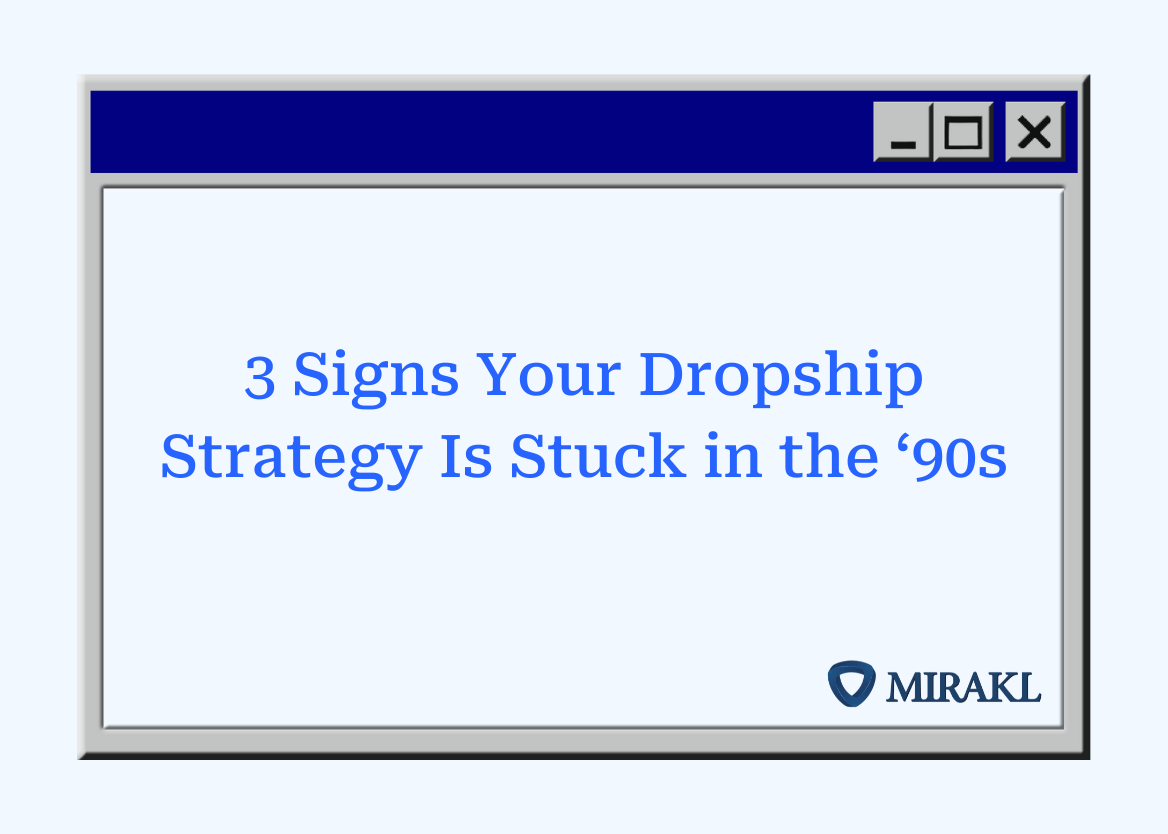3 Signs Your Dropship Strategy Is Stuck in the ‘90s: A Less-Than-Perfect Shopping Experience

A personalized, one-stop-shop online shopping experience is one of the biggest determinants of customer loyalty – no matter the size of the company or the industry. According to Salesforce’s recent State of the Connected Consumer report, 65% of customers expect companies to adapt to their changing needs or preferences.
While companies pour more money into tech solutions – Gartner projects that IT spending in eCommerce is forecast to grow by 7.3% annually over the next 3 years – buyers are still shopping around. 41% of consumers report switching brands in the last year in search of better product selection and variety.
Between clear customer signals and heightened IT investments, how is it possible that retailers are still failing to build the shopping journey that their customers want? For many, the cause lies in a stagnant dropship model – one that prevents retailers from maximizing their partnerships with brands.
In the next few weeks, I’ll share with you insights learned from conversations with dozens of retailers that reveal how you can use your dropship strategy to deliver the shopping experiences that will get your customers coming back for more.
Let’s start with a big one: the eCommerce experience. There are three major challenges that legacy dropship systems are putting in your way:
1. Slow Vendor Onboarding Impacting Speed-to-Market
You spend months trying to find the brands that are a perfect match for your dropship business. Their style, product quality, even their commitment to sustainability is an important consideration for you to bring them onboard. After all, you want to keep your integrity to your customers that love to shop with you. But once you’ve found the perfect vendor, how long does it take for you to get them up and running?
A common hurdle that retailers face when dealing with legacy dropship tech is the amount of time and resources they have to invest in the vendor onboarding process. Whether you have complex documentation requirements, very long taxonomy, specific product description rules, integration requirements (eg. connect via EDI) or all of the above, your dropship platform needs to be able to handle complexity with ease.
That means both supporting all of the intricacies of your business, and offering tools to accelerate onboarding for new brands.
Let’s put it this way: if your vendor takes weeks to integrate new items, you’ll miss out on capturing the revenue from Cloud Slides, Fat Oil Lip Drip, or whatever the trending product of the month is on TikTok. Ensure your dropship solution offers flexible, self-service vendor and catalog onboarding tools and incorporates AI and automation throughout the entire process so that you can ride waves of demand, before your shoppers move on to the next trend.
In a chat with the Mirakl team, Snappy Gifts co-founder and CTO shared that rapid onboarding tools made it possible to expand their supplier base by 300%. “On average, we’ve been able to reduce the onboarding time by 3X, getting partners live and accepting orders within two weeks; previously it was upwards of 1+ months,” shared Dvir Cohen, Snappy Gifts CTO.
2. Lack of Catalog Variety
The work doesn't stop after finding and onboarding the right brands to a dropship program. Retailers frequently don't take full advantage of what they have to offer – and in today’s anything, anytime, anywhere economy, it’s time to embrace all of the categories that your vendors offer. Unowned inventory models like dropship are the perfect way to get those products in front of customers, without having to worry about the upfront cost of purchasing inventory and a logistical nightmare.
Winning wallet share from shoppers today isn’t just about repeat purchases; it’s also about the product expansion and the variety you have to offer. McKinsey data shows that cross-selling increases sales by 20% and profit by 30%. If you aren’t following the trends closely and adapting your catalog fast enough, you’re missing out on an opportunity to build loyalty – and increase cart size.
Bring your dropship strategy into the 21st century by ensuring that your platform offers the flexibility to get your vendors’ product details and attributes ready and published quickly, so you can stay a step ahead of your customers’ (extended) wish list. The best part is that, with dropship, you can extend your catalog fast while still keeping control of the end-to-end relationship with your shoppers.
3. Poor Product Detail Pages
Once vendors and their catalogs are onboarded, the question becomes: can customers actually find what they’re looking for? Clear and informative product detail pages (PDPs) make it easy for customers to navigate your website and find what they need.
Product images and descriptions are extremely or very important for 78% of shoppers when deciding to complete a purchase. In other words, you can’t afford to have poor or incomplete product pages for dropship inventory. This is another area where your dropship platform can play a starring role, making it easy and inviting for brands to submit complete product details. Ensure that your dropship solution offers a clear moderation workflow for validation or reject reasons, and has centralized communication directly from the platform. Add AI-powered capabilities to the mix, and boom! You can complete and enrich your PDPs more efficiently.
Delivering the online shopping experience your customers want will require product variety, newness and easy website navigation. When done right, dropshipping is a strong strategy for incremental revenue and supporting your profitability goal. Take a moment to reflect how your dropship solution is supporting your vendor and catalog onboarding and ensure your process is setting you up for success.
Ready to bring your dropship practices into the future? Connect with Mirakl's resident dropship expert, Luke Heffernan, to learn more.



